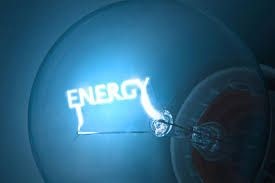In physics, energy is a property of objects which can be transferred to other objects or converted into different forms, but cannot be created or destroyed.[note 1] It is difficult to give a comprehensive definition of energy because of its many forms, but one common definition is that it is the ability of a system to perform work.[1] In SI units, energy is measured in joules, the energy transferred to an object by the mechanical work of moving it 1 metre against a force of 1 newton.[note 2]
All of the many forms of energy are convertible to other kinds of energy, and obey the conservation of energy. Common energy forms include the kinetic energy of a moving object, the radiant energy carried by light, the potential energy stored by an object's position in a force field,(gravitational, electric or magnetic) elastic energy stored by stretching solid objects, chemical energy released when a fuel burns, and the thermal energy due to an object'stemperature.
According to mass–energy equivalence, any object that has mass when stationary,(called rest mass) also has an equivalent amount of energy whose form is called rest energy. Conversely, any additional energy above the rest energy will increase an object's mass. For example, if you had a sensitive enough scale, you could measure an increase in mass after heating an object. Our Sun transforms nuclear potential energy to other forms of energy; its total mass does not decrease due to that in itself (since it still contains the same total energy even if in different forms), but its mass does decrease when the energy escapes out to its surroundings, largely as radiant energy.
For closed systems, the first law of thermodynamics states that a system's energy is constant unless energy is transferred in or out by Work or heat, and that no energy is lost in transfer. This means that it is impossible to create or destroy energy. The second law of thermodynamics states that all systems doing work always lose some energy as waste heat. This creates a limit to the amount of energy that can do work by a heating process, a limit called the available energy. Mechanical and other forms of energy can be transformed in the other direction into thermal energy without such limitations. The total energy of a system can be calculated by adding up all forms of energy in the system. Examples of energy transfer and transformation include generating or making use of electric energy, performing chemical reactions, or lifting an object. Lifting against gravity performs work on the object and stores gravitational potential energy; if it falls, gravity does work on the object which transforms the potential energy to the kinetic energy associated with its speed.
Living organisms require available energy to stay alive, such as the energy humans get from food. Civilisation gets the energy it needs from energy resources such asfossil fuels. The processes of Earth's climate and ecosystem are driven by the radiant energy Earth receives from the sun and the geothermal energy contained within the earth. While total energy is never lost, energy conservation refers to using less available energy, which may be considered lost when it changes to a less useful form, such as waste heat.[2]



